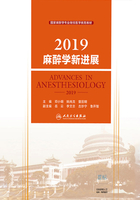
8 促肾上腺皮质激素释放激素调控肥大细胞的研究进展
促肾上腺皮质激素释放激素(corticotropin-releasing hormone,CRH)是下丘脑-垂体-肾上腺(hypothalamicpituitary-adrenal,HPA)轴的重要组分,在调控应激及相关疾病中起重要作用。肥大细胞是神经系统、血管和免疫系统之间联系的感受器和效应器。肥大细胞被视为人体的“哨兵”,在对外界的防御和过敏等应激反应中发挥着重要作用。越来越多的研究证据表明CRH对肥大细胞及其相关疾病有重要的调节作用。本文将对相关研究作一简要综述。
一、促肾上腺皮质激素释放激素(corticotropin-releasg homo, CRH)及其相关肽
CRH是由下丘脑合成的具有41个氨基酸的神经肽类激素。下丘脑的CRH主要存在于室旁核的小细胞神经元,这些CRH神经元的纤维主要投射到正中隆起,通过垂体门脉系统调节腺垂体促肾上腺皮质激素(adrenocorticotropic hormone,ACTH)的释放,后者再刺激肾上腺皮质合成分泌糖皮质激素。CRH是下丘脑-垂体-肾上腺(hypothalamicpituitary-adrenal,HPA)轴兴奋的中枢介质之一,更被视为HPA轴兴奋的中枢驱动力,是机体发生应激反应时发挥神经内分泌调节功能的关键激素。近年来的研究表明,CRH作为一种在体内广泛分布的神经递质/调质,参与了机体许多重要的生理功能,如器官或者内脏感觉、心血管活动、情绪反应以及学习记忆等。目前CRH主要分为2类,即CRH和尿皮质激素(Urocortin,Ucn)。
CRH在不同种的哺乳动物,如人类、灵长类动物、食肉动物、啮齿类动物等中具有高度保守性。在中枢神经系统中,CRH在下丘脑室旁核分布最多。CRH也广泛存在于其他外周组织,如消化道和胎盘等。
Ucn与CRH氨基酸序列具有高度相似性,被列为CRH家族成员。Ucn分为UcnⅠ、UcnⅡ、UcnⅢ 3个亚型。其中UcnⅠ含有40个氨基酸的神经肽,结构与CRH类似。UcnⅠ在哺乳动物大脑中的动眼神经副核中表达最多,同时也存在于心脏、血管细胞及子宫内膜等组织中,但总体还是在外周表达的更广泛。UcnⅡ由38个氨基酸组成,它的序列与人类、大鼠的CRH具有34%的同源性。UcnⅡ广泛表达于周围组织,尤其在皮肤和骨骼肌组织中。UcnⅢ则与CRH的相关性较小,它的表达区域与CRH的表达几乎没有重叠。
二、CRH受体(corticotropin-releasing hormone receptor, CRH-R)分型
CRH受体包括三种亚型,CRH-R1、CRH-R2、CRH-R3。CRH-R1在哺乳动物中枢神经系统表达丰富,在外周系统却表达有限。CRH-R2的中枢分布却较为局限,但外周表达较高,主要表达在外周如心血管和骨骼肌等。CRH-R1、CRH-R2与配体有着明显不同的亲和力。其中CRH和UcnⅠ与CRH-R1的亲和力较高,UcnⅡ和UcnⅢ与CRH-R2的亲和力较高。2001年CRH-R3被分离出来与CRH-R1有着较高的同源性。在CRH-R1/2敲除鼠中枢注入CRH后,ACTH释放量无明显改变,表明该受体可能不参与激活HPA轴,其特性和作用有待于进一步研究。由于CRH-R存在多种亚型且有着不同的组织分布,故其可以激活多种信号转导途径,产生丰富的生物学效应。
三、CRH对肥大细胞的调节作用
肥大细胞是一种多功能的免疫细胞,起源于CD34+/CD117+的骨髓源细胞,进入相应组织器官后受不同环境影响分化为不同的成熟型肥大细胞。肥大细胞一般沿血管或体表分布,表达有多种细胞表面受体,因此其分化、迁移和激活易受外界环境影响。故肥大细胞被视为人体的“哨兵”,在对外界的防御和过敏等应激反应中发挥着重要作用。
肥大细胞表面表达大量的CRH-R1和CRH-R2,对CRH具有高度的敏感性。肥大细胞症患者血清中的CRH和骨髓肥大细胞中CRH-R表达增高。同时有报道表明应激是肥大细胞相关疾病发生和加重的主要危险因素,例如过敏,哮喘以及肠易激综合征等。肥大细胞受到CRH信号刺激后被激活,导致细胞脱颗粒,释放IL-6、TNFα等一系列炎性递质。尽管已知肥大细胞在应激事件中高度激活,但应激调节肥大细胞功能和疾病病理生理学机制仍不清楚。
在肥大细胞依赖性IgE介导的被动全身过敏反应模型中,预防给予CRH-R1拮抗剂antalarmin可减轻肥大细胞脱颗粒和体温过低的症状。而将肥大细胞表面CRH-R1敲除后,被动全身过敏反应产生的血清组胺含量,体温,以及其临床分数与对照组相比得到了恢复,同时肥大细胞脱颗粒和肠道通透性也受到抑制。有研究表明CRH通过增加环磷酸腺苷诱导肥大细胞分泌血管内皮生长因子,这一作用可被CRH-R1拮抗剂antalarmin阻断,而CRH-R2拮抗剂astressin 2B则对其无作用。以上研究结果揭示了CRH-R1信号在肥大细胞脱颗粒反应中的积极调节作用。
而针对CRH-R2对肥大细胞的调节作用的研究则具有不同的结果。有实验证实如果用SCF和IL-6培养人脐带血培养肥大细胞(human cord blood-derived cultured mast cells,hCBMCs)10周后,其表面可以表达CRH-R1和CRH-R2两种受体。如果在最后3周内加入IL-4培养后,仅仅表达CRH-R2一种受体。进一步的分析表明,在6小时内加入IL-1或LPS只会增加CRH-R2基因表达。CRH无法诱导hCBMCs分泌IL-6,但可诱导hCBMCs释放IL-4。这说明CRH-R2在肥大细胞受到炎症刺激时会上调。但也有实验得出了与上述研究相反的结果,即CRH-R2功能的丧失会加重肥大细胞脱颗粒、促进IgE介导的过敏反应和心理应激诱导的肠屏障功能障碍。而肥大细胞表面的CRH-R2通过阻滞钙触发性钙释放通道,抑制各种刺激导致的脱颗粒反应,表明CRH-R2也可以负调控肥大细胞激活。总之在单细胞水平中,CRH受体和配体结合的净效应不仅仅是由一个单独的CRH的作用途径所决定的,而是通过平衡现有的信号通路而最终表现出来的。
四、CRH调控肥大细胞在相关疾病中的作用
皮肤是人体最大的器官,经常与外界环境接触。CRH通过激活靠近丰富感觉神经末梢的皮肤肥大细胞,增加皮肤过敏反应和其他皮肤病的发病率。科学家认为皮肤是大脑的“阑尾”。最近的证据表明,许多在中枢神经系统中表达的基因也在动物的表皮区域中表达,这表明确实存在“皮肤脑”。而皮肤也被证实具有其等效的HPA轴。
皮肤应激反应,例如紫外线辐射就会促进CRH释放,导致皮肤肥大细胞脱粒,增加局部血管通透性。急性应激也可加重大鼠皮肤迟发性超敏反应和慢性接触性皮炎,其作用涉及导致大鼠皮肤血管通透性增加和真皮肥大细胞显著增多,且依赖于CRH-R1。若服用CRH会引起外周血管扩张和脸红,使人联想到肥大细胞活化。事实上皮内给药CRH和Ucn可激活小鼠和人类皮肤肥大细胞表面的CRH-R1,促进肥大细胞活化,增加皮肤血管通透性。而利用肥大细胞缺陷鼠或CRH-R1拮抗剂antalarmin处理后则不存在该现象,说明CRH引起的皮肤病变是肥大细胞和CRH受体依赖性的。
IBS是临床常见的功能性肠病,心理应激是IBS发病重要因素。实验证明IBS患者结肠黏膜CRH含量明显高于正常对照组。大鼠腹腔或静脉注射CRH或Ucn后,可引起回盲部及近端结肠的长时程集合暴发性峰电位,结肠传递时间缩短。而注射高剂量注射CRH时,则出现水样泻。
肥大细胞广泛分布于胃肠道,研究发现IBS患者肠黏膜肥大细胞数量增多,脱颗粒比例增加,且与患者腹痛、腹部不适症状的严重程度相关,故肥大细胞在IBS的病理机制中发挥着关键作用。由于肥大细胞含有丰富的CRH,并在肥大细胞膜上发现了CRH-R的存在,且IBS小鼠肠道CRH免疫组织化学含量同肠道肥大细胞数呈正相关,提示肥大细胞可能是肠道CRH的主要分泌细胞之一。有研究表明IBS患者静脉注射CRH后降结肠的活动要明显高于健康对照组,并且促进了结肠黏液分泌以及肥大细胞蛋白酶的释放。Castgaliuolo等发现在肥大细胞缺陷小鼠腹腔及脑室注射CRH,并不引起结肠活动,更证实了CRH在肠道组织中的CRH的生物学功能与肥大细胞相关。应激反应使小鼠结肠黏膜的通透性增高,但这种作用可以被CRH受体拮抗剂和肥大细胞稳定剂色甘酸钠所拮抗,说明CRH和肥大细胞共同参与了应激导致肠道屏障功能障碍的过程。
近年来应激反应开始引起科学家的广泛关注,科学家提出了“应激学说”和“全身适应综合征”的概念,揭示了机体在应激后的各种生理系统变化。常见的应激原有紧张、恐惧、寒冷等,而手术创伤作为外科学范围内最常见的一种应激原,其强度和其对机体造成的影响远大于普通应激原的作用。手术应激可导致血-脑屏障(blood brain barrier,BBB)通透性升高,炎症信号通过受损的BBB传递进入中枢系统,对中枢神经系统造成不可逆的损伤。我们课题组前期工作已经证实脑内肥大细胞脱颗粒在外科术后BBB通透性升高中的起到重要作用。然而,值得深思的问题是:手术是如何导致脑内肥大细胞被激活并脱颗粒?
手术应激状态时,下丘脑室旁核接收到中枢神经系统的信息,兴奋HPA轴。而CRH被认为是HPA轴的引爆激素。脑内肥大细胞在下丘脑广泛分布,特别位于含有CRH的神经末梢附近,可被手术应激所激活。研究证实:急性应激可激活大鼠脑内肥大细胞,CRH抗血清预处理阻断了这一作用。提前在下丘脑注射肥大细胞稳定剂色甘酸钠可以缓解CRH引起的BBB损伤。利用转基因小鼠,研究者发现应激只会引起肥大细胞存在的脑区中BBB破坏,但对肥大细胞敲除鼠BBB无影响。
虽然目前人们对CRH如何在手术应激中调控肥大细胞知之甚少,但是由于肥大细胞可借助于其“预贮存”和“新合成”颗粒所释放的神经活性物质在术后神经免疫反应中发挥着催化剂和募集者的作用,我们有理由相信手术应激导致大量CRH释放,很可能通过激活附近肥大细胞表面CRH受体,调节肥大细胞功能,进而产生相应的术后应激反应。
五、结语
肥大细胞是抵抗病原体、过敏原、毒素和组织免疫反应等应激反应的第一道防线。因此在接下来的研究中,我们应该把肥大细胞视为应激连锁反应中的重要起始环节,而CRH与肥大细胞的联系可能是调控该此连锁反应的靶点,研究两者的交互效应和其中机制,将为临床寻找有效的防治措施提供新的策略。
参考文献
1.Vale W,Spiess J,Rivier C,et al. Characterization of a 41-residue ovine hypothalamic peptide that stimulates secretion of corticotropin and beta-endorphin. Science,1981,213(4514):1394-1397.
2.Lockwood C J. Stress-associated preterm delivery:the role of corticotropin-releasing hormone. Am J Obstet Gynecol,1999,180(1 Pt 3):S264-S266.
3.Vaughan J M,Donaldson C J,Fischer W H,et al. Posttranslational processing of human and mouse urocortin 2:characterization and bioactivity of gene products. Endocrinology,2013,154(4):1553-1564.
4.Venihaki M,Sakihara S,Subramanian S,et al. UrocortinⅢ,A Brain Neuropeptide of the Corticotropin-Releasing Hormone Family:Modulation by Stress and Attenuation of Some Anxiety-Like Behaviours. Journal of Neuroendocrinology,2004,16(5):411-422.
5.Dautzenberg F M,Hauger R L. The CRF peptide family and their receptors:yet more partners discovered. Trends in Pharmacological Sciences,2002,23(2):71-77.
6.Arai M,Assil I Q,Abou-Samra A B. Characterization of three corticotropin-releasing factor receptors in catfish:a novel third receptor is predominantly expressed in pituitary and urophysis. Endocrinology,2001,142(1):446-454.
7.Li N,Zhang X,Dong H,et al. Bidirectional relationship of mast cells-neurovascular unit communication in neuroinflammation and its involvement in POCD. Behavioural Brain Research,2017,322:60-69.
8.Harvima I T,Nilsson G. Stress. The neuroendocrine system and mast cells:current understanding of their role in psoriasis. Expert Rev Clin Immunol,2012,8(3):235-241.
9.Theoharides TC,Petra AI,Stewart JM,et al. High serum corticotropin-releasing hormone(CRH)and bone marrow mast cell CRH receptor expression in a mastocytosis patient. J Allergy Immunol,2014,134(5):1197-1199.
10.Heffner K L,Kiecolt-Glaser J K,Glaser R,et al. Stress and anxiety effects on positive skin test responses in young adults with allergic rhinitis. Annals of Allergy,Asthma &Immunology,2014,113(1):13-18.
11.Andrae D A,Patrick D L,Drossman D A,et al. Evaluation of the Irritable Bowel Syndrome Quality of Life(IBSQOL)questionnaire in diarrheal-predominant irritable bowel syndrome patients. Health and quality of life outcomes,2013,11(1):208.
12.Priftis K N,Papadimitriou A,Nicolaidou P,et al. Dysregulation of the stress response in asthmatic children. Allergy,2009,64(1):18-31.
13.Theoharides T C,Alysandratos K,Angelidou A,et al. Mast cells and inflammation. Biochim Biophys Acta,2012,1822(1):21-33.
14.Ayyadurai S,Gibson A J,D Costa S,et al. Frontline Science:Corticotropin-releasing factor receptor subtype 1 is a critical modulator of mast cell degranulation and stressinduced pathophysiology. Journal of Leukocyte Biology,2017,102(6):1299-1312.
15.Cao J,Boucher W,Kempuraj D,et al. Acute Stress and Intravesical Corticotropin-Releasing Hormone Induces Mast Cell Dependent Vascular Endothelial Growth Factor Release From Mouse Bladder Explants. The Journal of Urology,2006,176(3):1208-1213.
16.Papadopoulou N G,Oleson L,Kempuraj D,et al. Regulation of corticotropin-releasing hormone receptor-2 expression in human cord blood-derived cultured mast cells. Journal of Molecular Endocrinology,2005,35(3):R1-R8.
17.D’Costa S,Ayyadurai S,Gibson A J,et al. Mast cell corticotropin-releasing factor subtype 2 suppresses mast cell degranulation and limits the severity of anaphylaxis and stress-induced intestinal permeability. The Journal of allergy and clinical immunology,2018,S0091-6749(18):31586-31590.
18.Theoharides T C,Donelan J M,Papadopoulou N,et al. Mast cells as targets of corticotropin-releasing factor and related peptides. Trends in Pharmacological Sciences,2004,25(11):563-568.
19.Holland N D. Early central nervous system evolution:an era of skin brains? Nature Reviews Neuroscience,2003,4(8):617-627.
20.Pisarchik A,Slominski A. Corticotropin Releasing Factor Receptor Type 1:Molecular Cloning and Investigation of Alternative Splicing in the Hamster Skin. Journal of Investigative Dermatology,2002,118(6):1065-1072.
21.Slominski A,Ermak G,Mazurkiewicz J E,et al. Characterization of corticotropin-releasing hormone(CRH)in human skin. The Journal of clinical endocrinology and metabolism,1998,83(3):1020-1024.
22.Lytinas M,Kempuraj D,Huang M,et al. Acute Stress Results in Skin Corticotropin-Releasing Hormone Secretion,Mast Cell Activation and Vascular Permeability,an Effect Mimicked by Intradermal Corticotropin-Releasing Hormone and Inhibited by Histamine-1 Receptor Antagonists. International Archives of Allergy and Immunology,2003,130(3):224-231.
23.Theoharides T C,Singh L K,Boucher W,et al. Corticotropin-releasing hormone induces skin mast cell degranulation and increased vascular permeability,a possible explanation for its proinflammatory effects. Endocrinology,1998,139(1):403-413.
24.Singh L K,Boucher W,Pang X,et al. Potent mast cell degranulation and vascular permeability triggered by urocortin through activation of corticotropin-releasing hormone receptors. The Journal of pharmacology and experimental therapeutics,1999,288(3):1349-1356.
25.Santos J,Yates D,Guilarte M,et al. Stress neuropeptides evoke epithelial responses via mast cell activation in the rat colon. Psychoneuro endocrinology,2008,33(9):1248-1256.
26.Tache Y,Martinez V,Wang L,et al. CRF1 receptor signaling pathways are involved in stress-related alterations of colonic function and viscerosensitivity:implications for irritable bowel syndrome. British journal of pharmacology,2004,141(8):1321-1330.
27.Simrén M,öhman L,Göteborgs U,et al. Pathogenesis of IBS:role of inflammation,immunity and neuroimmune interactions. Nature Reviews Gastroenterology & Hepatology,2010,7(3):163-173.
28.Vicario M,Guilarte M,Alonso C,et al. Chronological assessment of mast cell-mediated gut dysfunction and mucosal inflammation in a rat model of chronic psychosocial stress. Brain,Behavior,and Immunity,2010,24(7):1166-1175.
29.Castagliuolo I,Wershil B K,Karalis K,et al. Colonic mucin release in response to immobilization stress is mast cell dependent. The American journal of physiology,1998,274(6 Pt 1):G1094-G1100.
30.Wallon C,Söderholm J D. Corticotropin-Releasing Hormone and Mast Cells in the Regulation of Mucosal Barrier Function in the Human Colon. Annals of the New York Academy of Sciences,2009,1165(1):206-210.
31.Finnerty C C,Mabvuure N T,Ali A,et al. The Surgically Induced Stress Response. Journal of Parenteral and Enteral Nutrition,2013,37(5_suppl):21S-29S.
32.Esposito P,Gheorghe D,Kandere K,et al. Acute stress increases permeability of the blood-brain-barrier through activation of brain mast cells. Brain Research,2001,888(1):117-127.
33.Esposito P. Corticotropin-Releasing Hormone and Brain Mast Cells Regulate Blood-Brain-Barrier Permeability Induced by Acute Stress. Journal of Pharmacology and Experimental Therapeutics,2002,303(3):1061-1066.